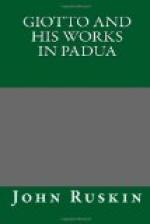* * * * *
XXIII.
THE MARRIAGE IN CANA.
It is strange that the sweet significance of this first of the miracles should have been lost sight of by nearly all artists after Giotto; and that no effort was made by them to conceive the circumstances of it in simplicity. The poverty of the family in which the marriage took place,—proved sufficiently by the fact that a carpenter’s wife not only was asked as a chief guest, but even had authority over the servants,—is shown further to have been distressful, or at least embarrassed, poverty by their want of wine on such an occasion. It was not certainly to remedy an accident of careless provision, but to supply a need sorrowfully betraying the narrow circumstances of His hosts, that our Lord wrought the beginning of miracles. Many mystic meanings have been sought in the act, which, though there is no need to deny, there is little evidence to certify: but we may joyfully accept, as its first indisputable meaning, that of simple kindness; the wine being provided here, when needed, as the bread and fish were afterwards for the hungry multitudes. The whole value of the miracle, in its serviceable tenderness, is at once effaced when the marriage is supposed, as by Veronese and other artists of later times, to have taken place at the house of a rich man. For the rest, Giotto sufficiently implies, by the lifted hand of the Madonna, and the action of the fingers of the bridegroom, as if they held sacramental bread, that there lay a deeper meaning under the miracle for those who could accept it. How all miracle is accepted by common humanity, he has also shown in the figure of the ruler of the feast, drinking. This unregarding forgetfulness of present spiritual power is similarly marked by Veronese, by placing the figure of a fool with his bauble immediately underneath that of Christ, and by making a cat play with her shadow in one of the wine-vases.
It is to be remembered, however, in examining all pictures of this subject, that the miracle was not made manifest to all the guests;—to none indeed, seemingly, except Christ’s own disciples: the ruler of the feast, and probably most of those present (except the servants who drew the water), knew or observed nothing of what was passing, and merely thought the good wine had been “kept until now.”
* * * * *
XXIV.
THE RAISING OF LAZARUS.
In consequence of the intermediate position which Giotto occupies between the Byzantine and Naturalist schools, two relations of treatment are to be generally noted in his work. As compared with the Byzantines, he is a realist, whose power consists in the introduction of living character and various incidents, modifying the formerly received Byzantine symbols. So far as he has to do this, he is a realist of the purest




